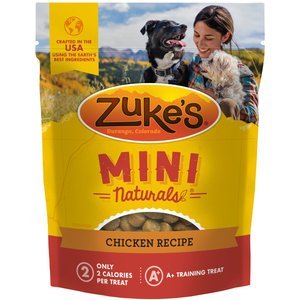Is your dog overweight? The good news is that, like people, dogs can lose weight successfully with a dog weight-loss plan. Learn how to tell if you have an overweight dog, and how to safely create a dog weight-loss plan.
How Do You Know if Your Dog Is Overweight?
There are a couple of easy ways to tell if your dog is too heavy. First, you can compare your dog visually to this body condition chart by Purina. If your dog’s body condition score is anything higher than a 5, then they are too heavy.
Another way to identify if your dog is overweight is by using your hands to check your pup’s body fat. Simply ask your dog to stand and feel their ribs right behind their front legs. They should feel like the back of your hand. If your dog’s ribs feel squishy, like your palm, then your dog is too heavy. If they stick out like your knuckles, then your dog is too thin.
If your dog is overweight, a dog weight-loss plan can help your pup lose unhealthy pounds of body fat. Without a plan, dog weight loss takes much longer and might not happen at all.
Devising a Successful Dog Weight-Loss Plan
Basically, the calories going out need to be higher than the calories going in. Your veterinarian will be your greatest ally in figuring out the specifics. Together, you and your vet can create a safe and effective dog weight-loss plan that includes:
- A goal weight in mind
- The total amount of daily calories that your dog can consume
- A weight-loss diet for dogs
- The length of time needed for your dog to reach his goal weight
- An exercise plan
- A promise from everybody in the household to follow the plan—even grandma who feeds the dog cookies when you aren’t looking (because without buy-in from the whole family, your pup will not lose the weight)
Your veterinarian also can check your dog for any health conditions, such as hormonal disorders, that might make it harder for them to lose weight, as well as prescribe pet pain medication if your dog avoids exercise because of painful arthritic joints. And most vet offices will let you weigh your dog regularly to check your progress—free of charge.
So, say your dog weighs 75 pounds and is 15 pounds overweight. You can ask your veterinarian to calculate how much your dog should be eating each day, which is based on your pet’s ideal weight. (Alternatively, you can use this nutrition calculator by Pet Nutrition Alliance, to do the math for you as well.)
10 Tips for Helping Your Dog Stay on a Weight-Loss Plan
To increase your chances of being successful, follow these 10 commandments of dog weight loss:
- Meal feeding is recommended. If you free-feed your pup, then put his food down in the morning, remove the bowl when the food is gone, and keep it away until the next day. Don’t keep filling up the bowl.
- Do not use a self-feeder dog bowl unless you can control the portions.
- Break the daily dry dog food allotment into multiple small meals.
- If your dog gulps all his food and then stares at you for more, consider using a slow feeder dog bowl, like the Ethical Pet slow feeder dog bowl, to help him slow him down.
- If your dog begs for treats, then feed him raw dog-safe vegetables, which are low in calories and high in fiber. Cucumber slices, green beans and carrots all are safe for pups.
- Another option for a begging dog, is to take him for a walk.
- If he continues to beg, toss a few kibbles (like 5) for him to fetch.
- Switch your overweight dog to a weight-loss diet for dogs. Many people simply reduce the amount of regular food they feed, but this can lead to a nutrient imbalance. Prescription weight-loss diets, like Hill’s metabolic diet weight management dog food, typically are better at facilitating weight loss than over-the-counter weight-loss formulas.
- If you are training your pet, then use a low-calorie training treat like Zuke’s Mini Naturals Chicken Recipe Training Dog Treats, which have less than 3 calories per treat.
- If you give your dog dental treats, use a low-calorie option, like Get Naked weight management dental chew sticks.
How To Tell if Your Dog Weight Loss Plan Is Working
Obviously, you will know if your dog weight loss plan is working if your pup is losing weight. Take advantage of your veterinarian’s scale with monthly to check-ins to monitor his progress. These fun visits also get your pet more comfortable at the vet office.
Dogs can lose 3-5 percent of their starting body weight safely per month, and most dogs can reach their goal weight within 3-6 months. If your pup isn’t losing any weight, then verify that no one is sneaking your dog extra goodies (grandma!) or that your dog has a hormonal condition, such as hypothyroidism or Cushing’s Syndrome, which can make weight loss difficult.
With the right tools and motivation, any couch potato pup can become a sleek canine machine.
Share:













